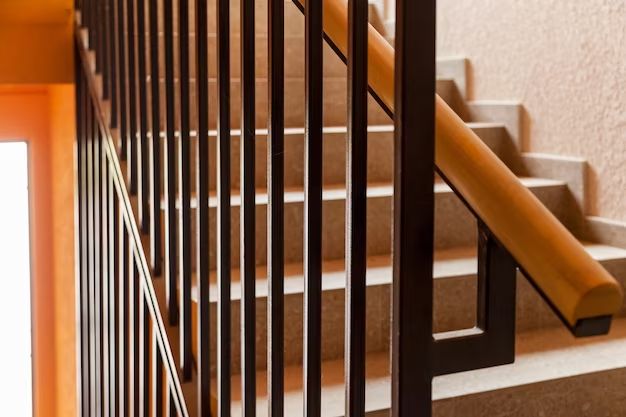When choosing wood for an exterior stair railing, there are several important factors to consider to ensure durability and longevity. The main considerations are weather resistance, strength and stability, aesthetics, and cost. By evaluating these aspects, you can determine the best type of wood for your specific needs and application.
Page Contents
Weather Resistance
Because exterior railings are constantly exposed to the elements, it’s crucial to select a wood that can withstand sun, rain, snow, and fluctuations in temperature and humidity. Some of the best woods for weather resistance include:
- Teak – Teak has natural oils that make it highly resistant to rot, cracking, and water damage. It has an exceptional lifespan of 50+ years.
- Cedar – Cedar contains oils that act as natural preservatives. It has a high tolerance for weather shifts while resisting insects and decay.
- Redwood – Redwood has a natural resistance to moisture, insects, and rotting due to its high tannin content.
- White oak – White oak is less porous than other oaks, so it better resists water absorption. It has a tight grain pattern that helps repel insects.
- Ipe – Ipe is an incredibly dense Brazilian hardwood that repels moisture, rot, and termites. It can last 40+ years outdoors.
Avoid weather-vulnerable woods like pine, spruce, and fir, which tend to crack, warp, and rot when exposed to the elements. Preference should be given to woods with natural oils, tannins, and tight grain patterns.
Strength and Stability
In addition to withstanding weather, exterior stair railings need to be structurally sound under the weight load and pressure of consistent use. Look for woods with these strength properties:
- Density – Denser woods can better handle wear, stress, and repeated grasping/leaning.
- Hardness – Harder woods don’t dent as easily from bumps and strikes.
- Stiffness – Stiffer woods resist excessive bending and sagging under weight loads.
Some great strong and stable wood options include:
- Brazilian walnut – Extremely hard and dense while still resistant to weathering.
- Mahogany – Tropical mahogany offers excellent density to prevent dents, scratches, and warping.
- White oak – Very hard and stiff with tight, stable grain to prevent sagging.
- Larch – A very strong softwood that machines well while withstanding weather shifts.
- Teak – In addition to weather-resistance, teak is quite hard and rigid.
Aesthetics
The visual appeal of the wood should also factor into your decision. Characteristics to consider include:
- Grain patterns – The flowing lines and uniqueness of each piece of wood add natural beauty. Curly grains offer visual interest.
- Color tones – Varying wood hues ranging from light tans to deeper browns and reds can complement different architectural styles.
- Finishes – Staining or sealing exterior railings enhances color while providing extra weather protection.
Some particularly attractive and workable woods for railings include:
- Ipe – Has a mix of browns and reds with a tight, swirling grain when finished.
- Cedar – Light reddish-brown color that can be enhanced with stains.
- Mahogany – Deeper reddish-brown tone with an elegant, straight grain pattern.
- Redwood – Light pinkish-red hue that weathers to a silver-gray over time.
Cost Considerations
Budget is often a primary factor when building a stair railing. While premium exotic hardwoods offer unparalleled longevity and performance, they come at a steep price. More cost-effective options include:
- Pressure-treated pine – Inexpensive and readily available, but requires regular upkeep.
- Redwood – A moderately priced softwood that ages gracefully.
- Cedar – Affordable and easily workable with natural weather resistance.
- Cypress – Works well and looks nice at a lower cost point.
Here is a comparison of price ranges per linear foot for different wood types:
| Wood Type | Price Range per Linear Foot |
|---|---|
| Brazilian Walnut | $18 – $24 |
| Mahogany | $12 – $18 |
| Ipe | $9 – $15 |
| Teak | $12 – $15 |
| Cedar | $5 – $8 |
| Redwood | $6 – $10 |
| Pressure-Treated Pine | $3 – $7 |
Though pricier, choosing a hardwood like ipe or mahogany can deliver long-term value from their exceptional longevity. Cedar and redwood offer the best bang for your buck. Pressure-treated pine is the cheapest option but requires the most maintenance.
Cost of Labor
Along with material costs, factor in expenditures for stair railing installation. Prices vary based on complexity of design, additional features like lighting or cables, and local labor rates. On average, expect to pay:
- $45 – $65 per hour for carpentry labor
- $800 – $1,200 for a full railing spanning 10 steps
- $1,500 – $3,500+ for an intricate custom railing system
Hiring experienced professionals ensures proper installation and safety, so it’s worth the investment.
Conclusion
When selecting exterior stair railing wood, teak, ipe, cedar, and redwood consistently rise to the top. Teak offers unparalleled weather and insect resistance paired with strength and elegance. Ipe is extremely hardy and dense for structural integrity. Cedar and redwood blend weather-resistance, workability, and affordability. Mahogany, Brazilian walnut, oak, and larch also make suitable choices under certain circumstances.
The best course is determining the required performance abilities, aesthetics, and budgetary constraints for your particular project. This helps narrow down which wood options make the most sense for your specific needs. Taking the time to carefully evaluate and select the ideal wood will ensure safe, sturdy, and visually appealing exterior stair railings that stand the test of time.
